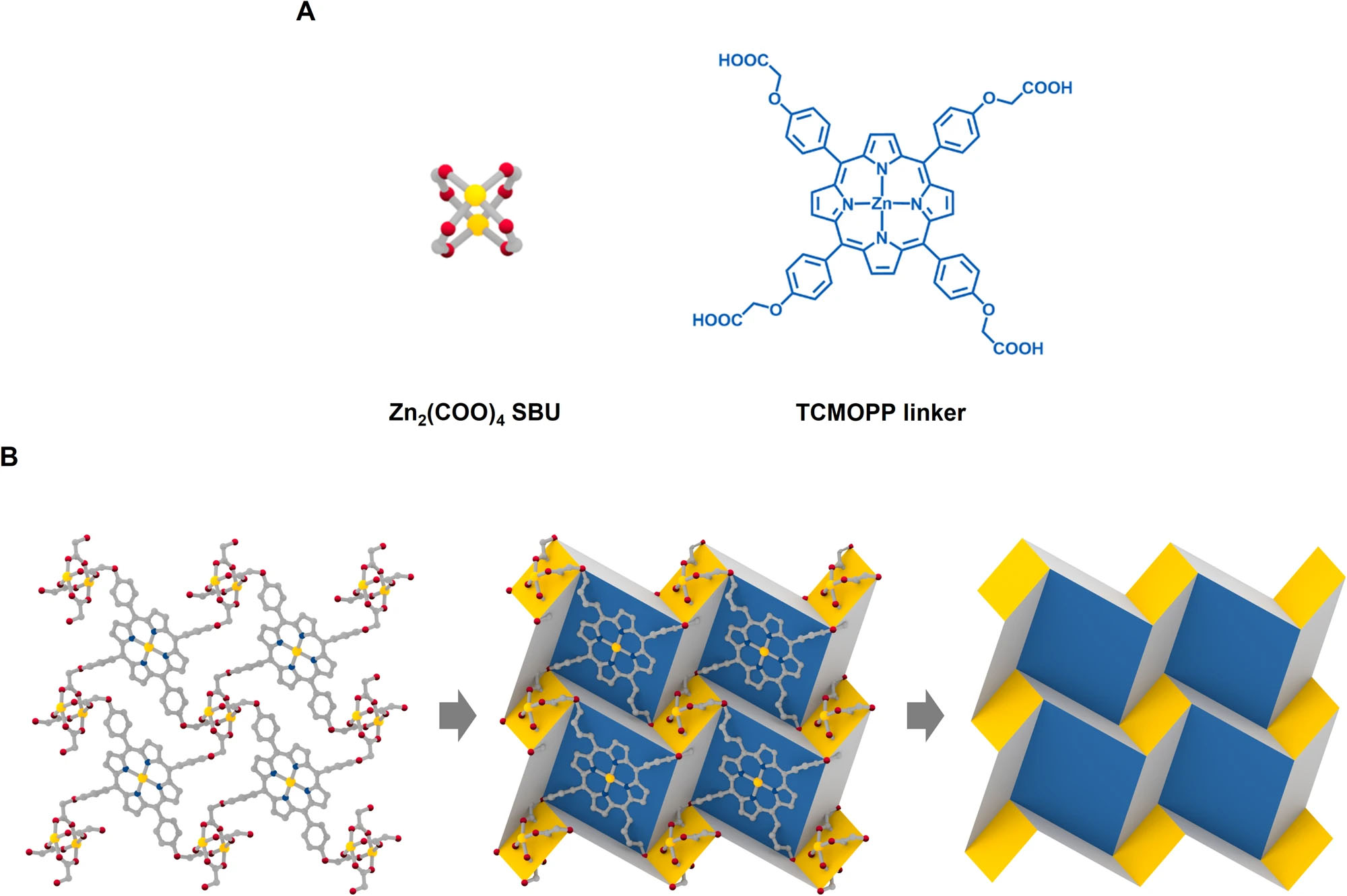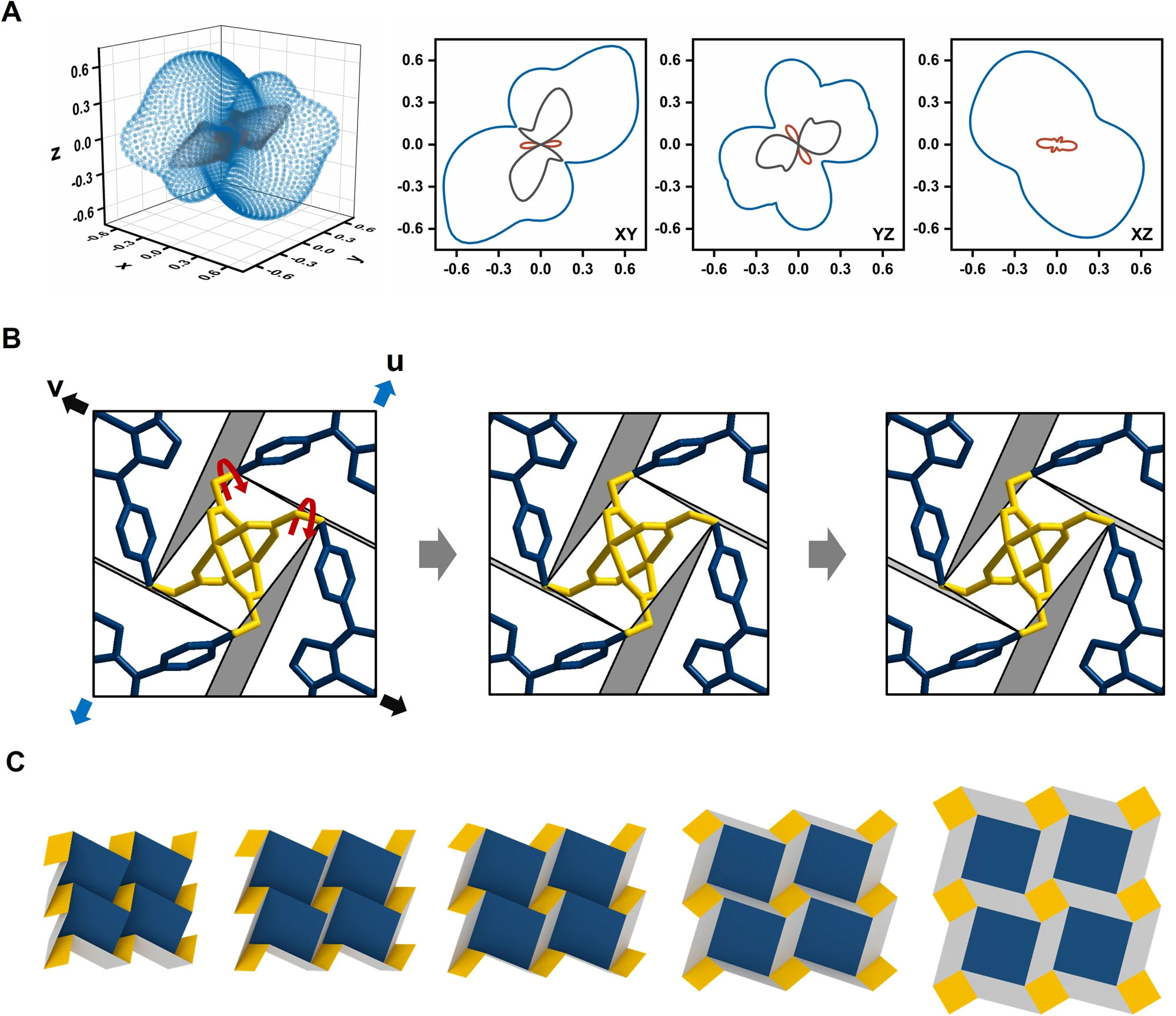| Dec 08, 2023 | |
Flexible metal-organic frameworks mimic origami folding at molecular scale |
|
| (Nanowerk Spotlight) For centuries, origami, the ancient art of paper folding, was used to create decorative figures for crafts and artwork. In recent decades however, origami principles have inspired technological innovations in engineering flexible mechanical metamaterials. These origami-based materials can reversibly fold and unfold in response to environmental changes, enabling applications from solar panels to medical implants. Yet mimicking the folding mechanism at microscopic, molecular scales remained an elusive goal. | |
| Now researchers have developed an adaptable metal-organic framework (MOF) material that dynamically changes shape by precisely following origami tessellations, the repeating folded patterns that enable paper structures to expand and contract. | |
| Published in Nature Communications ("Origamic metal-organic framework toward mechanical metamaterial"), this discovery of an “origamic” MOF introduces a completely new class of stimuli-responsive crystalline materials with exotic properties. It also opens possibilities for controlling molecular architectures with folding actuators and switches. | |
 |
|
| Crystal structure and origami tessellation unveiled in PPF-301. A Two building blocks for PPF-301: Zn2(COO)4 SBU and TCMOPP linker. Zn = yellow; C = gray; N = blue; O = red; all hydrogen atoms and solvent molecules are omitted for clarity. B Simplification of 2D porphyrinic MOF, leading to origami tessellation. Solvents and hydrogen are omitted for clarity. The blue and yellow tiles filled the TCMOPP linker and Zn SBU, respectively. Red balls are oxygen atoms of the aryloxy group. (© Nature Communications) | |
| For over 20 years, scientists have synthesized MOFs, coordination network materials assembled from metal nodes bonded by organic linkers, notable for extreme porosity enabling uses like hydrogen storage. While some flexible MOFs were found to shift configurations in response to external factors like temperature changes, none replicated origami folding patterns seen at macroscale dimensions. | |
| “The list of origami applications in technology is rapidly growing, as exemplified by solar cells, foldable electronics, lithium-ion batteries and biomedical devices,” said paper co-author Dr Wonyoung Choe, but shrink operating principles down past nanoscale for integration with microelectronics faced persistent obstacles. | |
| The crucial innovation now enabling single crystalline MOFs to exhibit origami tessellations involved identifying and incorporation particular flexible molecular subcomponents to serve as placeholders for folds and hinges. | |
| “Origami design principles are now extended to art, science, engineering, architecture and further to industry, because of the fascinating deployable nature of origami architectures,” explained Dr Choe. | |
| In this research, pivoting phenylene units with rotating aryl-oxygen bonds situated throughout the framework function as swivel points to guide globally coordinated shape shifts. | |
| Researchers produced samples by using solvothermal synthesis to self-assemble custom porphyrin-based linkers with paddlewheel zinc nodes into a layered two-dimensional MOF designated PPF-301. Advanced analysis combining single crystal x-ray crystallography from 100-380K with computational modelling then revealed PPF-301 undergoes temperature dependent structure changes following the mountain and valley crease patterns of an origamic Miura-ori tessellation. This distinctive architecture belongs to a broader class of highly collapsible, yet stiff accordion structures typically used for solar panel covers needing to unfurl after launch. | |
 |
|
| A 3D surfaces and 2D polar plots of Poisson’s ratio obtained by ELATE visualization. Blue and black lines represent the maximal and minimal positive values, respectively. The red line represents the minimal negative values over all possible values. B Top view of the atomic movement corresponding to the minimal Poisson’s ratio. The folded gray areas unfold as the stress is applied along u direction, as shown in the figure from left to right in the figure along the gray arrows. blue arrow; u = (−0.766, 0.438, 0.471) and black arrow; v = (−0.314, 0.385, −0.868) directions. C Deployable mechanism of DCS origami tessellation. (© Nature Communications) | |
| Investigations found the framework layers steadily flatten out when heated up as the swiveling angle between tiles progressively widens by almost 4 degrees, just as the underlying origami geometry dictates. | |
| “The discovery of the 2D tessellation hidden in the 2D MOF unveils origami mechanics at the molecular level,” stated Dr. Choe. Moreover, because the entire rearrangement sequence is thermally reversible without hysteresis, repeatedly folding and unfolding this atypical MOF looks probable through temperature cycling. | |
| Computer simulations next confirmed origami principles also impart metamaterial characteristics, with PPF-301 manifesting a negative Poisson's ratio in the softest deformation direction. This means counterintuitively this crystalline solid sheet expands laterally when stretched, unlike most materials which thin under tension. | |
| Additionally, the sizable 160 M K-1 coefficient of thermal expansion measured is distinctly larger than almost all other 2D metal-organic frameworks. These qualities arise directly from the Miura-ori patterning effectuating coordinated molecular motions. | |
| Altogether the architecture imparts an unusual pairing of stimulant responsiveness with mechanical anomalies that foils assumptions about innate material limitations. By emulating paper origami to endow a MOF with built-in mobility through strategic placement of flexible joints, researchers inaugurated an unexplored realm of previously inconceivable responsive crystalline compounds. | |
| Early prospective applications center on electrically or photonically reconfiguring devices for sensing and displays. Long term research trajectories clearly point towards integrating trigonally tiled 2D frameworks as molecular actuators. Introduction of custom asymmetric linkers or selective bond excitation may also localize folding deformations for information encoding. | |
| Origami tessellations as averaged across bulk crystals here operate analogously to three-dimensional metamaterials containing substructure motifs much smaller than operating wavelengths. This research now opens the door to bridging bottom-up chemical synthesis with top-down lithographic methods to construct hybrid microelectromechanical systems (MEMS) integrating origami MOF elements. | |
| “The origami tessellations can be applied to advanced design principles of MOFs to assemble dynamic frameworks exhibiting origamic movements,” explained Dr. Choe. Additionally incorporating responsive chromophores or spin carriers into the backbone may enable modulating optoelectronic or quantum processing behaviors using reconfiguration. | |
| By pinpointing how to impute paper folding concepts into Metal-Organic Framework materials synthesis, this breakthrough discovery establishes an entirely new subfield of stimuli-responsive mechanically active crystalline compounds. Findings provide both vital conceptual advances for stimuli-responsive materials science as well as initialization of an uncharted territory filled with numerous unknown origami MOF metastable phases awaiting discovery through structural fine-tuning. | |
| Just as macroscale civil engineering and aerospace designs capitalize on origami manufacturability benefits, upcoming efforts will transfer similar adaptable reliability into molecularly engineered components and devices. | |
| Overall this research furnishes an innovative molecular platform able to mimic the ancient art of origami paper folding. Insights gained lay groundwork for multiplying the portfolio of multifunctional metamaterials through incorporating a combination of extreme mechanics and adjustable porosity. By flexing coordinated swiveling motions guided by programmable crease patterns, this new generation of folding crystalline materials points toward previously inconceivable responsive properties emergent across transformative length scales. | |
 By
Michael
Berger
– Michael is author of three books by the Royal Society of Chemistry:
Nano-Society: Pushing the Boundaries of Technology,
Nanotechnology: The Future is Tiny, and
Nanoengineering: The Skills and Tools Making Technology Invisible
Copyright ©
Nanowerk LLC
By
Michael
Berger
– Michael is author of three books by the Royal Society of Chemistry:
Nano-Society: Pushing the Boundaries of Technology,
Nanotechnology: The Future is Tiny, and
Nanoengineering: The Skills and Tools Making Technology Invisible
Copyright ©
Nanowerk LLC
|
|
|
Become a Spotlight guest author! Join our large and growing group of guest contributors. Have you just published a scientific paper or have other exciting developments to share with the nanotechnology community? Here is how to publish on nanowerk.com. |
|
